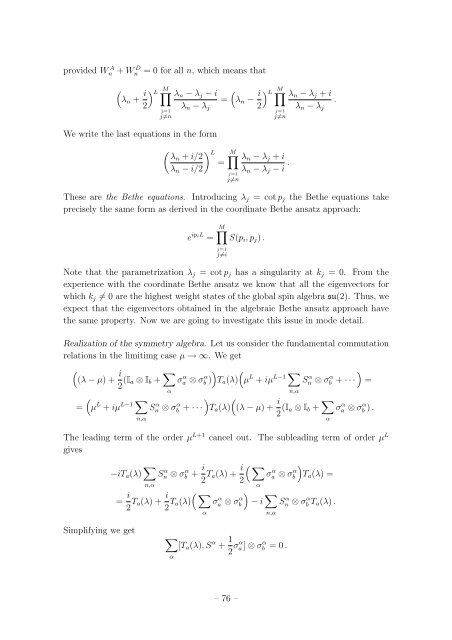Student Seminar: Classical and Quantum Integrable Systems
Student Seminar: Classical and Quantum Integrable Systems
Student Seminar: Classical and Quantum Integrable Systems
Create successful ePaper yourself
Turn your PDF publications into a flip-book with our unique Google optimized e-Paper software.
provided W A n + W D n = 0 for all n, which means that<br />
(<br />
λ n + i ) L ∏ M<br />
λ n − λ j − i<br />
(<br />
= λ n − i 2 λ<br />
j=1 n − λ j 2<br />
j≠n<br />
We write the last equations in the form<br />
( ) L λn + i/2<br />
=<br />
λ n − i/2<br />
M∏<br />
j=1<br />
j≠n<br />
) L M<br />
∏<br />
j=1<br />
j≠n<br />
λ n − λ j + i<br />
λ n − λ j − i .<br />
λ n − λ j + i<br />
λ n − λ j<br />
.<br />
These are the Bethe equations. Introducing λ j = cot p j the Bethe equations take<br />
precisely the same form as derived in the coordinate Bethe ansatz approach:<br />
e ip iL =<br />
M∏<br />
S(p i , p j ) .<br />
j=1<br />
j≠i<br />
Note that the parametrization λ j = cot p j has a singularity at k j = 0. From the<br />
experience with the coordinate Bethe ansatz we know that all the eigenvectors for<br />
which k j ≠ 0 are the highest weight states of the global spin algebra su(2). Thus, we<br />
expect that the eigenvectors obtained in the algebraic Bethe ansatz approach have<br />
the same property. Now we are going to investigate this issue in mode detail.<br />
Realization of the symmetry algebra. Let us consider the fundamental commutation<br />
relations in the limitimg case µ → ∞. We get<br />
(<br />
(λ − µ) + i 2 (I a ⊗ I b + ∑ α<br />
) (<br />
σa α ⊗ σb α ) T a (λ) µ L + iµ ∑ )<br />
L−1 Sn α ⊗ σb α + · · · =<br />
n,α<br />
=<br />
(<br />
µ L + iµ ∑ ) (<br />
L−1 Sn α ⊗ σb α + · · · T a (λ) (λ − µ) + i 2 (I a ⊗ I b + ∑<br />
n,α<br />
α<br />
σ α a ⊗ σ α b ) .<br />
The leading term of the order µ L+1 cancel out. The subleading term of order µ L<br />
gives<br />
−iT a (λ) ∑ Sn α ⊗ σb α + i 2 T a(λ) + i ( ∑ )<br />
σa α ⊗ σb<br />
α T a (λ) =<br />
2<br />
n,α<br />
α<br />
= i 2 T a(λ) + i (<br />
2 T ∑ )<br />
a(λ) σa α ⊗ σb<br />
α − i ∑ Sn α ⊗ σb α T a (λ) .<br />
α<br />
n,α<br />
Simplifying we get<br />
∑<br />
[T a (λ), S α + 1 2 σα a ] ⊗ σb α = 0 .<br />
α<br />
– 76 –

















